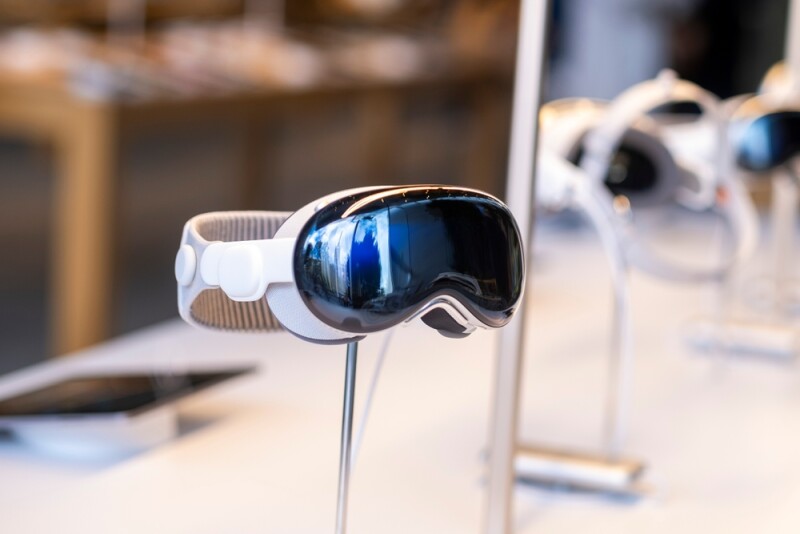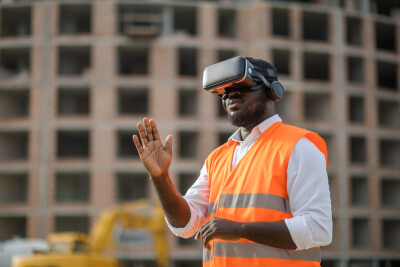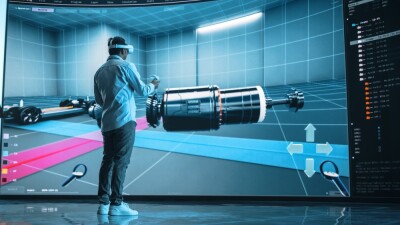Virtual reality headsets represent one example of wearables in the construction industry that show great promise for productivity, with one example being to help train apprentices perform tasks with real-time feedback in the application.
That said, they are not without their faults. VR headsets are known to have ergonomics problems causing discomfort that have been widely reported, with studies on the topic published in scholarly journals like Virtual Reality, Frontiers in Psychology, and in the book Advances in Ergonomics in Design. Universities like Oregon State and Northern Illinois have published their own research and guidelines to avoid common risks associated with VR and its ergonomic complications.
All of this is to say: The launch of Apple’s Vision Pro headset has upped the ante with what the future of mixed reality might look like, with popular tech reviewers like Marques Brownlee calling the eye-tracking functionality “the closest thing to ‘magic’” he’s experienced with a tech product.
But as revolutionary as the Vision Pro is, the device in its first generation is already seeing its first major hurdles in convincing its early adopters to hold onto the device past the initial 14-day return policy window courtesy of its high price tag of a whopping $3,500 and a combination of usability issues (including ergonomics), the Verge reports.
With Apple’s recent stumbles, in this article I look to answer a few questions. What known ergonomics issues exist today in the current batch of VR headsets available on the market? Did Apple prioritize form over function in their Vision Pro headset? Is the construction industry realistically ready to widely adopt VR headsets considering the ergonomics and implicit safety hazards? And if not, what will the next generation of VR headsets need to address to make wider adoption in the industry more feasible?
The Ergonomics Problem with VR Headsets Compounded in Apple’s Vision Pro
Comfort with VR headsets has been a known issue. Writing for Inverse, associate editor Ian Carlos Campbell discusses how making VR headsets comfortable is a tall order.
To put the matter bluntly while risking oversimplifying, the common adage of the technical challenges of VR headset ergonomics goes something like: You’re strapping a computer, complete with its many bits and structural components, to your face.
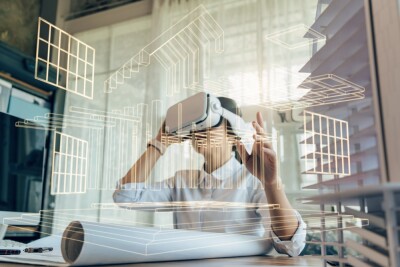
Campell advises that manufacturers focus on fixing what can be reined in:
- For the Manufacturer Targeting the Buyer with the Means to Obtain a One-off Device – Focus on making the device custom-molded to the wearer’s face to modulate the final form relative to the wearer’s cranial dimensions, similar to the extent of customization seen in the motorcycle industry from the likes of Arch Motorcycle that offers custom fitment and ergonomics tailor-made to individual riders for an unrivaled performance and riding experience.
- For the Manufacturer Targeting the Masses – Cut down on weight and balance – Campell points out that the introduction of Meta’s Quest Pro delivered a more compact size thanks to the decision to swap out Fresnel lenses for pancake lenses and redistributing the batteries from the front to the back of the device “for a more balanced fit,” an issue Apple hasn’t seemed to address as CNET reported it to be “top heavy.”
- Modularity - One of the points Facebook/Meta’s founder Mark Zuckerberg makes in his response to trying Apple’s Vision Pro for the first time is how computing has gone back and forth with open versus closed systems becoming the dominate force. A colleague and I have discussed how Apple’s “Walled Garden” make it harder to escape their ecosystem the deeper you’re invested, and how their “MAYA (Most-Advanced-Yet-Acceptable)" approach to product design helps them gradually prepare the wider market for more seemingly radical industrial design decisions that, in turn, seem logical. Zuckerberg explains while there are certainly benefits to this approach, both from Apple’s perspective and the user (e.g., every product automatically synchronizes because they’re part of the same ecosystem), there are benefits to an open system – as Campell points out, it allows for third-party manufacturers like Razer to make a superior adjustable head strap for Meta’s Quest 2 and facial interface that Campell describes “adequately address the comfort problems of VR.” Meanwhile, Apple’s head strap flaws have led some users to turn to mods to address the comfort issues they’re experiencing in their headsets.
So, to answer the question, did Apple prioritize form over function in their Vision Pro headset? Simply put: Perhaps, at least at this moment.
The problem with Apple’s Vision Pro may lie somewhere in its industrial design philosophy. They have long prioritized user-centric design and the integration of form and function, which would make you think that the first iteration of its “spatial computing” headset would better address the ergonomics challenges that present in this type of product.
Disclaimer: I want to stress that it’s important to consider that the Apple Vision Pro is in its first generation, so naturally some problems may arise the company will provide solutions for and continuously improve upon. I mainly aim to point out where certain design considerations could have worsened the ergonomic experience.
They’ve also prioritized “uncompromising quality,” minimalism, and attention to detail, which have led the unboxing of their products to be events in and of themselves.
To achieve this, they often apply high-quality finishes and premium materials, like stainless steel in its watches (where other manufacturers may rely on plastics), or recycled aluminum, both which help them achieve their environmental goals while providing the added bonuses of durability, aesthetic appeal, and a premium feel.
These choices, particularly in a wearable like the Vision Pro, present a couple issues:
- Price – Using plastics in manufacturing is inherently cheaper, accounting for an overall cost savings of 25-50% over metal. And while plastics are inherently worse for the environment, consider how companies like Samsung have turned to 20% recycled ocean-bound plastic in the construction of their phones. There are also other examples of more sustainable alternatives in manufacturing outside of just recycled plastic depending on the product requirements.
- Weight – In addition to the lower cost materials used in products like the Meta Quest Pro, which help drive its price down considerably (while Zuckerberg is also committed to lowering costs to make the devices more accessible to consumers), it also helps with its weight. Apple’s Vision Pro is constructed with glass and an aluminum alloy frame, with aluminum as a material weighing 2.25 times heavier than plastics. For reference, in a head-to-head against the Meta Quest 3, one comparison guide said, Apple’s Vision Pro is “on the heavier side [...] On the flip side, the Meta Quest 3 offers a lighter weight of 515 grams, thanks to the all-plastic form.”
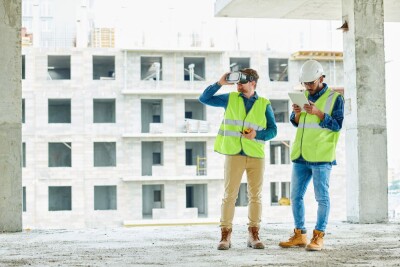
Is the AEC Industry Ready for VR & Which Manufacturers Are Poised to Deliver Solutions?
Scholarly research proposing “recommendations for accessible and ergonomic design” in the next generation of virtual reality stress that “current systems appeal to niche consumers who are willing and able to use VR despite bulky hardware and accessibility barriers in software,” recommending ways “in which designs can be iterated to produce more ergonomic and accessible systems for a broader range of users.”
A 2019 master’s thesis out of Marquette into the ergonomics implications of a helmet-mounted augmented reality system showed Microsoft’s Halo Lens to be useful in manufacturing applications with positively responding surveyed participants suggesting they believed “AR could give consistency to training,” but negative feedback including “HoloLens is not comfortable to wear and it is hard to adjust hardhat/lens to see the screen,” the “unit is a bit heavy,” etc. (96). And with Microsoft’s most current version of the device ranging from $3,500-$5,199, applying the same technology may be a steep cost for construction companies.
With the current ergonomic and considerable cost of headsets from Apple and Microsoft, Meta may be the most feasible route for companies looking to pilot an AR/VR construction technology program considering their commitment to improving comfort, reducing price, and modularity via a network of third-party accessory developers.
Additional research proposes ergonomic design and a “motion capture suit” to address common musculoskeletal disorders associated with VR headsets through the introduction of a motion capture suit and a head-mounted display, so manufactures may take notice as they iterate on future-generation devices.
Bottom Line
Nobody is disputing how revolutionary Apple’s Vision Pro headset is in bringing its idea of “spatial computing” into the future. That said, with a hefty $3,500 price tag and a load of ergonomics problems, in its current generation, the Apple Vision Pro might not be the most feasible for AEC applications where known ergonomics issues are, shall we say, exaggerated.
That said, Apple brings maniacal focus to the user experience and strategic thinking to every product it launches.
Let's consider, for a moment, how EV brands like Tesla launched an expensive version of its first EVs before rolling out more affordable models. Or, how Harley-Davidson launched its first electric motorcycle at a starting price of nearly $30,000, only to spin its electric motorcycle operations into its own brand and offer a lower LiveWire One price of $22,799 and a smaller, agiler model that cut that price by $7,300.
I don’t have a crystal ball to look into Apple’s strategic plans, nor am I sure if professionals in the AEC industry are among those who they’d like to target as customers in future iterations of its spatial computing hardware products. That said, if I were a betting man, I wouldn’t bet against Apple, nor would I rule it out that a more affordable version of the device may be in the works, and user feedback will be listened to (especially these early returns that should serve as users shouting, not suggesting, their complaints). Let’s not forget that Apple has brought back features it previously removed (e.g., MagSafe) and removed other ones (e.g., Touch Bar) based on popular and unpopular demand, respectively. It’s not unreasonable to predict that a newer iteration of Apple’s Vision Pro will reasonably address the complaints users are currently experiencing, nor is it to imagine a scenario where a future device from Apple may be a more feasible contender for the AEC industry. Only time will tell!


